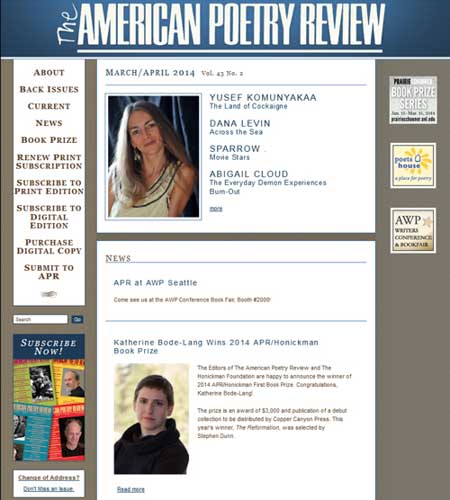The American Poetry Review- March/April 2014
The name Donald Sterling underlines an un-sterling moment in ‘post-racial’ America, delivered in sound bites that, in many ways, reveal sensibilities lurking beneath the ‘post’ in post-racial. Sterling’s girlfriend or personal assistant, V. Stiviano, was the messenger, thanks to mobile devices that heighten our desire to spy on intimate conversations. Indeed, Stiviano had the ball; and then came the slam-dunk that catapulted the message to first-class scandal. Soon, race as topic of discussions and conversations in living rooms and social media is on center stage once again, quietly intrusive, at times, to a point where it taints the spirit of any material you’re reading in the context of race.
The name Donald Sterling underlines an un-sterling moment in ‘post-racial’ America, delivered in sound bites that, in many ways, reveal sensibilities lurking beneath the ‘post’ in post-racial. Sterling’s girlfriend or personal assistant, V. Stiviano, was the messenger, thanks to mobile devices that heighten our desire to spy on intimate conversations. Indeed, Stiviano had the ball; and then came the slam-dunk that catapulted the message to first-class scandal. Soon, race as topic of discussions and conversations in living rooms and social media is on center stage once again, quietly intrusive, at times, to a point where it taints the spirit of any material you’re reading in the context of race.
This taint is palpable when I read this issue of The American Poetry Review, particularly because of Martha Collins’s essay “Writing White, an Introduction”—which echoes other essays written a few years ago by Major Jackson, Claudia Rankine, and Natasha Tretheway—which tries to address the issue of writing from “racialized experience” and why there’s a “dearth of poems written by white poets that address racial issues.” Certainly, ‘address’ here touches on terrains of truth and authenticity, and begs the question: to what extent are racial issues racial? Collins argues that
we’re all writing race whether we like it or not: a writer of color will see the whiteness in my poems even if I don’t. And for many years I did not. For me, as for many white people, race was—whether I would have phrased it this way or not—something others had: white was default, was no race.
So then, to her, race is embedded in language, or rather the language of a writer’s imagination, that even if one consciously avoids writing about racial issues, in the end, racialized experience is already factored unconsciously in one’s work.
In the other notable essay in this issue, “Toward a Postmodern Humanism: Information, Layering, and the Composite Poem,” Tony Hoagland quietly echoes how identity embeds itself in poetic language, by virtue of reality itself: “As a poet and a person, I want to include both Lyme’s disease and moonlight in my poems. I want economics and racial reality, and bootleg pharmaceutical companies in India.” To Hoagland, the imagination of poetry today stands in and against terrains of hyperactive rivers of information and technologies that inform and test a poem’s sense of place and time; thus, he poses a challenge of how a poem can “manage and orchestrate it all.” His answer: the composite poem, a poem that “approaches the real through an aesthetic process of sampling, counterpoint, and dialectic.”
While Hoagland drives rigorous arguments about the poems of Spencer Reece, Anne Carson, and Robert Haas to make his point, he spends more time discussing the “power of disarray” in Tomas Tranströmer’s work wherein the Swedish poet “layers and conglomerates the spiritual and the informational, the existential and the scientific, the narrative and the lyrical into his poems”. In Tranströmer’s “Oklahoma”, Hoagland muses about its neutral tone and the lack of connective language and transitions: “This motel is a foreign shell. With a rented car / (like a big white servant outside the door). / Nearly devoid of memory, and without profession, / I let myself sink to my midpoint.” Here, devoid goes with shell. But there’s something unconventional about the notion of servant as a car, an image that disrupts the seeming connectivity between sink and devoid, which underlines an experience of exile, of something obliterated, deserted.
There are many gems in this issue, like the long excerpt of James Baldwin’s “Gypsy,” which unfolds like a novel:
Not knowing why,
for no reason,
he touched his balls
and heard his wife,
Elizabeth,
call, coming!
This is pure Baldwin, his men are forever minted with fires that conspire. While Abigail Cloud does not mention balls in “Tryst,” its intensity feels raw, nevertheless, in which need and desire raise the temperature of objects:
Her nerves banged
an anthem to the sexy Bartlett
pears, the sexy palm plant draped
in the corner, the mirror like a mouth
on the wall. . . .
Although the repetition of “sexy” throughout the poem creates rhythm, I had a Hoagland moment, and wanted it disconnected from the piece with something less descriptive, or perhaps something foreign to the poem like, say, television.
Like Cloud’s lyrical temperament, Yusef Komunyakaa’s “The Land of Cockaigne” makes love with a landscape, the mythical land of Cockaigne, a place of escape and ease from medieval peasant life: “A silhouette rides / the rope swing tied to a spruce limb, / the loudest calm in the marsh.” The silhouette is intriguing, because of the absence of identity, a face, but has some sort of momentum, not static. The poem feels like an ekphrastic piece, commenting on Pieter Bruegel’s “The Land of Cockaigne” dominated by bodies on the ground, particularly because of the line: “thick mud sewn up like bodies fallen / into a ditch, blooming, about to erupt.”
For lovers of poetry, any issue from this journal is an escape, like being in the land of Cockaigne. Its editors aspire to take its readers to the ultima thule of poetic imagination.
[www.aprweb.org]





